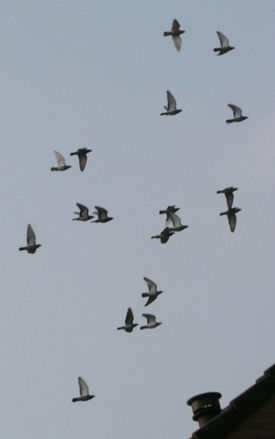Respiratory Disease Checklist
 The Common Signs of Respiratory Disease in Racing Pigeons are:
The Common Signs of Respiratory Disease in Racing Pigeons are:
- Panting after flying.
- Sneezing
- Loft flying decreases
- Race losses
- Eye and nostril discharge
- Swollen cere and sinus
- Stretching of neck and swallowing
- Yawning
The top race performance requires perfect health and fitness.
Performance relates directly to the efficiency of the respiratory and circulation systems to provide the dramatic increase in energy requirements for flight. For example, during normal loft flying the pigeon increases its oxygen consumption fifteen fold and when flying into a head wind the oxygen consumption increases by up to 30 times. These massive energy burdens can only be supported by good health and fitness.
A Check List For Respiratory Disease
Examine the nostril
Any discharge appearing at the nostril (be it watery, tacky or snotty) when applying sideways pressure to the wattle reflects a health problem of the nasal cavity.
Check inside the mouth
The nasal cavity connects with the mouth in an area we refer to as the choanal slit. Many fanciers look at this area during the racing season. A narrowing of the “slit” when there is infection of the nasal cavity accurately reflects the inflammation present throughout the upper airways. Obviously, inflammation in this area will affect the heat and water conservation functions of the nasal cavity and lower competitive performance. The converse is also true and I agree with the fanciers, who believe that a fully open “slit” is a sign of a bird in top form.
Panting after exercise
When a respiratory infection inflames the nasal cavity and upper airways the pigeon is less able to control the considerable heat production generated during flight. With certain respiratory infections the first sign noticed is panting after or during exercise. Panting is a mechanism which sheds excess heat rapidly. A fluttering motion in the neck (a form of panting) may also be seen in the overheated pigeon (this is called gular fluttering). Unfortunately both water and heat are lost with panting.
I often see panting when training birds land after a short toss. These birds are healthy but not yet in top condition or are in the moult and have short flights. Because panting is a mechanism to alleviate overheating, we see it in exercising birds on hot days. When panting is noticed within the loft on very hot days efforts to cool the loft must be taken. Special attention to temperature control within the transporters is essential for the health of the race birds.
We also see panting in unfit birds exercising early in the morning, late evenings or tightly around the loft. It is important for the fancier to differentiate between panting in the healthy pigeon and that caused by respiratory infections.
Respiratory disease involving both the lungs and airsac systems seriously impairs flying performance not only because of the failure of the oxygen delivery system but because the energy systems (liver, muscle etc) are also affected. Disease of the airsac system alone reduces performance because both the delivery of oxygen and the removal of waste products are impaired. The resultant cramping muscles make it impossible for the pigeon to fly.
Also see Panting in Racing Pigeons
Respiratory Disease Checklist by Dr. Rob Marshall
The Leading Online Pigeon Racing and Racing Pigeons Magazine – The Pigeon Insider









Nice Article, Surly there must be some meds made in America we can use, rather than ordering high dollar stuff imported from overseas…I would like to see an article on good home grown products, Thanks….Jer
Like Always , Great Information and this will be helpful to myself and others … Much appreciated , Thank You !
hi i just have a question around your respiratery section you mentioned about checking the slit if not open fully cam be a problem explain were this slit is i am looking for please
usefull guide. thankyou…………………
Tnx for this bird health great information
WHEN I SEE PANTING I TREAT WITH A MEDICATION CALLED 5IN 1 VERY HELPFUL RAY BROWER
thanks for this note
Hello Chris,
A very good article which most should look into more carefully. I believe most respiratory problems start in the loft due to poor venilation and high humidity. Also birds that spend alot of time in training crates with strange birds which might be infected. I have seen what poor ventilation can do especially when it rains for two or three days straight. Poor ventilation can destroy form almost overnight. If ventilation is off your birds are OFF. Thanks for reading.
Nick Demas
THANKS NICK I AGREE WHIT YOU. MY VENTILATION IS VERY GOOD IN MY LOFT. ITS NOW WINTER IN S A.SO IT IS VERY COLD HERE. WE TOSSES DURING THE WEEK AND THERE IS A LOT OF STRAYS THAT COMING TOO OUR LOFTS AND I THINK THAT IS WHERE OUR PROBLEMS STARTS.
Dear Sir
I would like to inform you that i am greatful to you for the immense konwledge and information that you have shared with me
A very good article really interesting,I find your articles are an excerlent read with great information keep up the good work,it really is a good read.
Mick
hi what is the problem when i am feeding my pigeons they cant swallow the food well. and when i feed and mix with oil they swallow easy